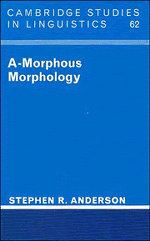Book contents
- Frontmatter
- Contents
- Acknowledgments
- Introduction
- 1 The study of word structure
- 2 Why have a morphology at all?
- 3 Is morphology really about morphemes?
- 4 The interaction of morphology and syntax
- 5 The theory of inflection
- 6 Some complex inflectional systems
- 7 Morphology in the lexicon: derivation
- 8 Clitics are phrasal affixes
- 9 The relation of morphology to phonology
- 10 How much structure do words have?
- 11 Composites: words with internal structure
- 12 Morphology and the typology of languages
- 13 Morphological change
- 14 Morphology as a computational problem
- References
- Index
10 - How much structure do words have?
Published online by Cambridge University Press: 10 January 2011
- Frontmatter
- Contents
- Acknowledgments
- Introduction
- 1 The study of word structure
- 2 Why have a morphology at all?
- 3 Is morphology really about morphemes?
- 4 The interaction of morphology and syntax
- 5 The theory of inflection
- 6 Some complex inflectional systems
- 7 Morphology in the lexicon: derivation
- 8 Clitics are phrasal affixes
- 9 The relation of morphology to phonology
- 10 How much structure do words have?
- 11 Composites: words with internal structure
- 12 Morphology and the typology of languages
- 13 Morphological change
- 14 Morphology as a computational problem
- References
- Index
Summary
The concern to be addressed in this chapter is a rather fundamental one: what do we find when we examine the internal form of a word? That is, when we consider the form of a word, what kinds of structure ought it to be taken to have, as a matter of its form? There is a tendency in doing linguistic analysis to assume that any information we can supply about linguistic elements constitutes a kind of “structure” that they have, but this clearly conflates several distinct notions. For instance, in discussing the word rear (as in When Trigger reared suddenly, Roy Rogers fell off), we can note that its source is Middle English reren, Old English rœran; and that its relation to modern English rise constitutes one of the few remaining pairs of English words illustrating Verner's Law. Surely, however, we would not want to say that this information is part of the structure of the word rear in the way that, for example, the organization of its phonological content into segments and syllables surely is. Information about the etymology of a word is properly given in the form of a description of its history and derivation from earlier forms; information about segmental and syllabic structure, on the other hand, is simply one aspect of the form or internal organization of the word itself.
- Type
- Chapter
- Information
- A-Morphous Morphology , pp. 256 - 291Publisher: Cambridge University PressPrint publication year: 1992



